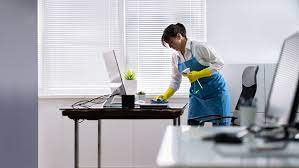Maintaining a clean office isn’t just about presentation. It affects productivity, staff health, and how your business is perceived. Yet, many workplaces get one thing wrong — the order of cleaning. Doing tasks in the wrong sequence means dirt gets re-spread, time gets wasted, and hygiene standards drop.
Let’s break down the correct cleaning order and why it matters.
Why order matters in office cleaning
Cleaning is more than scrubbing. Done right, it’s a system. Dust, bacteria and allergens behave predictably — and an effective clean follows that logic. Working from top to bottom and clean to dirty helps limit cross-contamination and makes every pass count.
1. Declutter first
Before you clean, you need access. Clear desks, empty bins, and remove items from surfaces and floors. Clutter blocks cleaning access and traps dust.
- Stack loose documents
- Move items from high-traffic zones
- Empty general and recycling bins
2. Dry dusting — start high
Begin with dry tasks, like dusting vents, shelves, and light fittings. Gravity works against you, so knock dust down before you wipe or mop.
Use:
- Microfibre cloths (reduce airborne particles)
- Extension dusters for high spots
3. Surface cleaning and disinfecting
Now that dust has settled, move to desks, counters, door handles and switch plates. Use a detergent first, then disinfect. Always follow dwell times listed on the product — that’s how it kills germs.
Don’t forget:
- Shared electronics (keyboards, phones)
- Communal areas like kitchens and meeting rooms
4. Spot clean vertical surfaces
Walls, glass panels and partitions often get overlooked. Use a damp cloth or streak-free cleaner. Don’t leave smudges — they reflect badly in client-facing zones.
5. Clean floors last
Now that everything above is clean, move to the floor. Start with dry vacuuming, then mop if needed. If you mop first, everything else ruins your work.
For carpeted spaces:
- Use HEPA-filtered vacuums
- Spot-treat any stains before they settle
For hard floors:
- Mop with a neutral cleaner
- Buff if necessary to remove residue
6. Final touches and ventilation
Replace bin liners. Straighten chairs. Open windows or turn on exhausts to remove odours and moisture. A clean office should smell clean — not chemical-heavy or stale.
Cleaning tip: Follow a schedule
Cleaning routines should be repeatable. Daily for high-touch areas, weekly for deep cleans, monthly for extras like vents or under-furniture zones.
The takeaway
Order makes all the difference. Skipping steps or doing them out of sequence leads to more work and poorer results. Whether you’re handling it in-house or outsourcing, insist on proper procedure.
To keep your office in check, consider a professional Office Cleaning service. Proper scheduling and trained staff mean the job’s done right the first time — and every time.
If your workplace needs consistent, reliable results, see more about Office Cleaning options that fit your building type, schedule and budget. Learn how Office Cleaning can improve your team’s wellbeing and keep your workplace inspection-ready.

